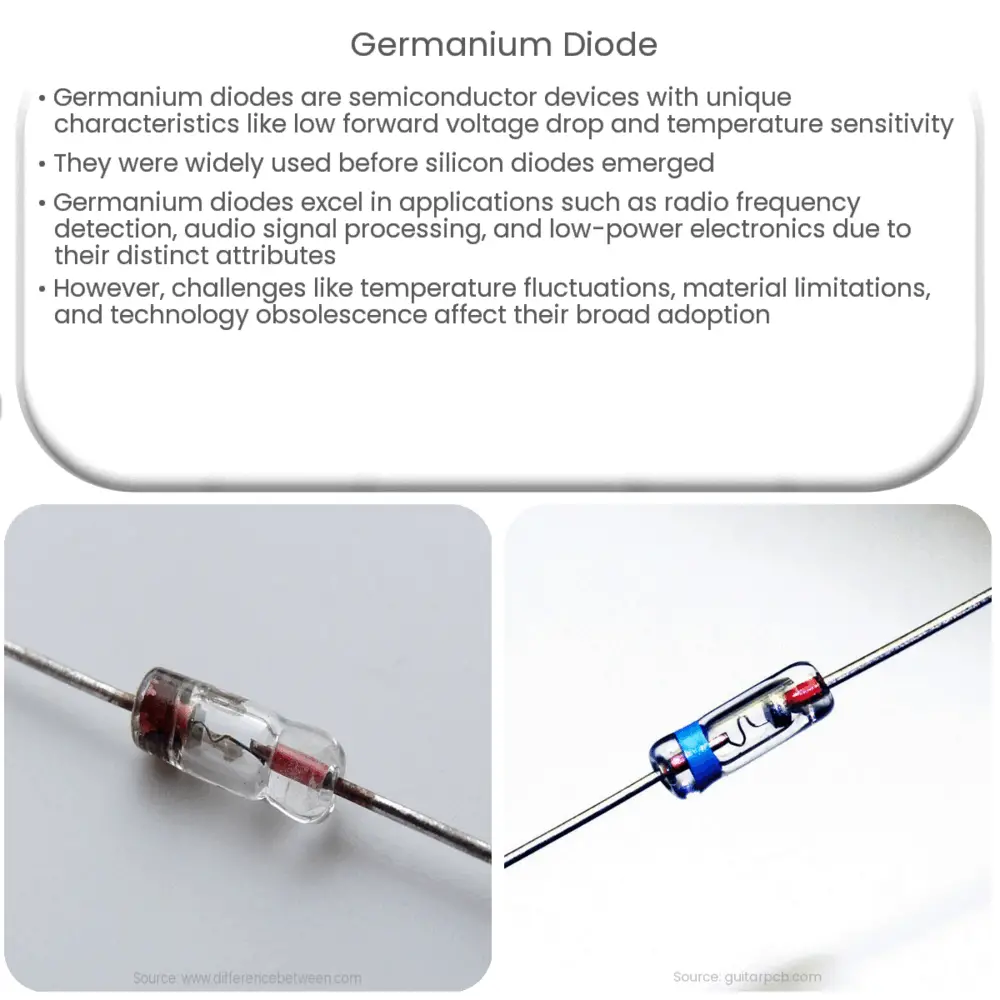Germanium diodes are semiconductors with low forward voltage drop, ideal for low-power electronics, RF detection, and audio signal processing.

Germanium Diode: A Comprehensive Overview
Introduction
Germanium diodes are semiconductor devices that have played a significant role in the electronics industry since their inception. Despite being gradually replaced by silicon diodes in many applications, they continue to be relevant and advantageous in certain scenarios. In this article, we will explore the fundamentals of germanium diodes, their characteristics, applications, and advantages compared to other types of diodes.
What is a Germanium Diode?
A germanium diode is a type of semiconductor diode that utilizes germanium (Ge) as its primary material. Diodes are electronic components that allow current to flow in one direction, known as the forward direction, while blocking current in the reverse direction. This characteristic makes diodes essential components in circuits where unidirectional current flow is necessary.
Germanium diodes were among the first semiconductor diodes to be developed and were extensively used before the emergence of silicon-based diodes. Germanium, a group IV element in the periodic table, was chosen as the primary material due to its unique electronic properties, which include a lower forward voltage drop and temperature sensitivity compared to silicon diodes.
Characteristics of Germanium Diodes
Germanium diodes exhibit a few distinct characteristics that differentiate them from other diodes:
- Low Forward Voltage Drop: Germanium diodes have a low forward voltage drop, typically around 0.3V, whereas silicon diodes have a forward voltage drop of around 0.7V. This lower voltage drop allows germanium diodes to operate at lower power levels, making them suitable for low-power applications.
- Temperature Sensitivity: Germanium diodes are more sensitive to temperature changes than silicon diodes. As the temperature increases, the forward voltage drop decreases, resulting in improved performance at higher temperatures. However, this sensitivity also makes them less suitable for applications with high-temperature fluctuations.
- Softer Knee Curve: The knee curve of a germanium diode is softer than that of a silicon diode. This means that the transition from the non-conducting to the conducting state is smoother, which can be advantageous in certain applications such as audio signal processing.
Applications of Germanium Diodes
While germanium diodes have been largely replaced by silicon diodes in many applications, they continue to be used in specific scenarios where their unique characteristics provide benefits. Some of these applications include:
- Radio Frequency (RF) Detection: Germanium diodes’ low forward voltage drop makes them ideal for detecting and demodulating weak radio frequency signals in vintage radio receivers and crystal radio sets.
- Audio Signal Processing: The softer knee curve of germanium diodes lends itself well to audio signal processing applications, such as guitar effects pedals, where a smoother and more natural-sounding distortion is desired.
- Low-Power Electronics: Due to their lower forward voltage drop, germanium diodes can be used in low-power electronic devices to minimize power consumption and extend battery life.
Advantages and Disadvantages of Germanium Diodes
Germanium diodes offer several advantages, but they also have some drawbacks compared to other types of diodes:
Advantages
- Lower Forward Voltage Drop: As mentioned earlier, the lower forward voltage drop of germanium diodes enables them to operate at lower power levels, making them suitable for low-power applications and increasing power efficiency.
- Softer Knee Curve: The smoother transition from non-conducting to conducting state allows for more natural-sounding audio signal processing, particularly in applications such as guitar effects pedals.
- High-Temperature Performance: The performance of germanium diodes can improve at higher temperatures due to their temperature sensitivity, which can be beneficial in specific applications.
Disadvantages
- Temperature Sensitivity: The temperature sensitivity of germanium diodes can be a disadvantage in applications with high-temperature fluctuations, as it can lead to instability and reduced reliability.
- Material Limitations: Germanium is less abundant and more expensive than silicon, making germanium diodes costlier to manufacture. Moreover, germanium has a lower thermal conductivity compared to silicon, which can result in increased thermal stress and potential device failure.
- Obsolete Technology: With the advancement of silicon-based diodes, germanium diodes have become somewhat obsolete, leading to less research, development, and industry support for these devices.
Conclusion
Germanium diodes, while gradually being replaced by silicon diodes, still hold their ground in specific applications where their unique characteristics offer advantages. Their low forward voltage drop, softer knee curve, and temperature sensitivity make them suitable for low-power electronics, radio frequency detection, and audio signal processing. However, the temperature sensitivity, material limitations, and obsolescence of the technology pose challenges to their widespread adoption. Ultimately, the choice of diode depends on the specific application and requirements, and germanium diodes remain a viable option for certain use cases.

